The Baader–Meinhof phenomenon is something everyone has experienced at some point in their lives. When you’re looking to get a new car and start considering one specific model in a specific color, suddenly you see them everywhere. It’s not that they’re suddenly more popular, it’s a selection bias predicated on your newfound interest in the subject (Fun fact: this phenomenon was first coined because of the Baader-Meinhof Group— a left-wing militant organization in West Germany which was responsible for the deaths of 34 business owners and national figures in the 1970s). A reporter noticed that he had never heard of the group before, and suddenly heard it twice within the same day. Eventually, the term stuck, although today you often hear it called something like “the blue car effect”.
Learning our landscape brings this phenomenon to the forefront of every hike. When you begin to learn new plants & evidence of ancient landscapes, this effect happens over and over; you’ve never noticed black locust trees, for example until you learn to recognize its sinewy-appearing bark (I often tell people it looks similar to a Chinese finger trap that’s been stretched).
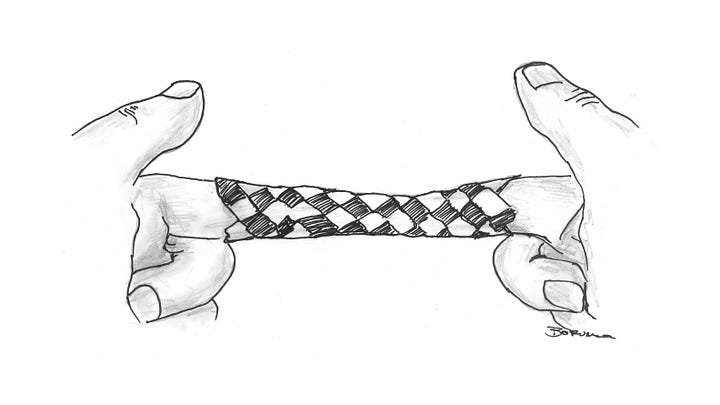

When we talk about reading the landscape, however, we aren’t talking about flora ID, necessarily, but rather trying to understand the landscape as it looked before it looked the way it does now.
Why is understanding the history of a landscape important? Here, in the eastern coast of the continent of North America, 95% of the landscape has been altered by humanity for timber, crops, grazing, housing, or industry. These different practices have different impacts on the land, in terms of the topsoil depth, past chemical usage, and the general landscape topography, and that’s not accounting for other major impacts on a site, such as major floods, hurricanes, tornados, mudslides, and fires. On a smaller scale, reading the landscape can tell us how to identify the history of the landscape by paying close attention to the various indicators of the history of the landscape such as standing deadwood, stumps, rotting logs, coppiced trees, and much, much more. Not only is being able to read the landscape important for us as land managers, but it further ties us deeper and more personally with the landscape, as it bares its history to us in a way we are not used to.
In Tom Wessels’s book Reading the Forested Landscape, he gives us snapshots of the woods and walks through the unique characteristics that we can quickly identify to start being better readers of the landscape. I want to walk through some of the history of farming on colonized lands and how those create different impacts on the soil, and from there talk about common things you’ll see on your hikes and what they indicate. Ultimately, by being able to do this, we can not onyl contextualize the history of the landscape around us in a way that ties it into our history— for example, following the history of a tree that once stood during the revolutionary war, that was blown down during the biggest storm of the century, which you can tell by seeing a clump of trees in a certain arrangement. It’s pretty cool to be able to do it, and it’s not hard.
No matter where you are, the first thing to start paying attention to is tree size. Are they all the same size, or are they a mix, or are there a few very large trees and then smaller trees, nothing really in between? We had covered in the forest succession piece a bit about the first trees that occupy a forest, and as the ecosystem evolves, they give way to the slower growing, longer-living trees. For most of the United States, these slower growing, longer-living trees are some variety of oak. A general rule, and again, this is kind of general, is to take the diameter of an oak and multiply it by 4 or 5 to estimate the age of the tree. White and red oaks grow at different speeds, so that’s why I say 4 or 5, but I don’t want to get too bogged down in detail. You can look up the growth factor of any tree species— which is that number you’re multiplying by the diameter, so, with a higher growth factor number, the slower a tree grows.1 For every foot diameter an oak tree is at breast height, the height you generally measure a tree’s diameter, the tree is about 50 years old. So if a tree is 3 feet in diameter, it’s likely close to 150 years old.
Going back to the idea of forest succession— those first succession tree species grow more quickly, so even if you don’t know the growth factor of a specific species, by knowing where they fall in succession we can estimate— first succession species are generally between 2 and 3 and a half, so while a white oak tree that’s 3 feet in diameter might be 150 years old, the 3 foot in diameter aspen right next to it is probably only 60-70 years old, which would mean that when that aspen just started growing, the oak was already almost 2 feet in diameter!
The Living Landscape
Let’s look a little closer at the living trees in the landscape. We can identify the stage of succession the forest is in through the species composition from the forest succession episode, and now we can appropriately age the trees, but let’s talk about the clustering of some of the trees, specifically a type of clustering known as coppicing. The idea of coppicing is when a tree is cut down to a stump and new shoots spring up from the same root ball. While this happens when you cut down, say, an oak tree, it also happens naturally if the tree is diseased, gets hit by lightning, a fire runs through the landscape, or anything else, really, as long as it’s a species that can coppice from dormant buds. Sometimes these trees may appear as though they are 3 separate, closely growing trees, and it takes some digging, quite literally— to find the outline of the original stump. The giveaway typically for identifying coppiced trees is that they will form a semi-circle pattern. Usually, when new sprouts shoot up from a stump, up to 25 shoots will spring forward, and they slowly shrink in number until, at the most, 6 or so remain— at least in nature without human intervention. These trees, even if they are a foot or more apart, are still essentially the same tree from the same root ball, from the same original tree. Because they’re from the same root ball, they’re able to grow more quickly, and their diameter doesn’t accurately provide an estimate of the tree’s— that is, the new growth from the same root ball’s— age.
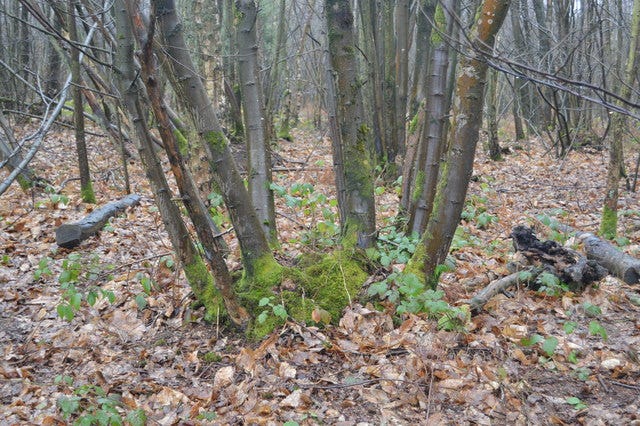
Now, when looking at the forest, like I said, you’d look for some evidence that would show some kind of mix of different ages of trees. If there appears to be, say, a bunch of 100 year old trees and a bunch of 15-20 year old trees, there’s a clear gap of trees by age— this is called discontinuity. This happens for one of two reasons— the growth of a young forest or the disturbance of an old forest. Generally, in young forests, as the canopy closes, their dense new shade keep new species from springing forward until the new canopy begins to either weaken, either from storms and branches dying off. Further, as the weaker canopy trees from this early succession forest start to die off, new gaps are created where new species can take advantage of the limited sunlight, typically slower-growing, more shade tolerant species like oaks. This young forest is clearly divided because of that first initial push towards sunlight, and it can take up to a century before these divisions become less clear. 2
When we look for evidence of disturbance in an old forest, our first focus should be in regards to the age gap that is missing. Were there any fires that might have destroyed those trees when they were saplings? Are there basal scars, that is, scars along the bark at the base of trees, to suggest a fire had taken place? What about standing deadwood? Standing deadwood can be indicative of a pest that may have wiped out a specific species, which may have been one of the main varieties for an age group of trees. Standing deadwood doesn’t even have to be standing— when we say standing deadwood, we mean trees that died standing up. The interesting thing about these trees is that they typically have certain markers that separate them from, say, a tree that fell in a storm. The wood will slowly dry the way firewood might— the bark will fall off and expose the bare wood, so when a downed tree lays on the ground barkless, that bark fell off before the tree fell on the ground. Further, by assessing the tree size, you can quickly surmise whether or not it could have been impacted by wind— if the tree has come down, generally, the trees taken down in storms are those in the upper canopy; if the tree in question is, say, 50 years younger than the canopy, it’s highly unlikely it was once part of the canopy.
We can look back to the coppiced trees— knowing they grow more quickly, is it possible those trees original trunks could have been damaged by the same event that wiped out the specific age-group that’s missing? Suddenly, we are starting to see the story of a landscape take place.
Cracks in the Mosaic
Now, let’s go back to that idea of discontinuity. Where else is there most obviously going to be discontinuity? In an abandoned field. There’s some easy ways to figure out where abandoned fields once stood. Generally, most fields maintain some trees for shade for livestock— these trees, grown with no competition, spread their branches far and wide to take in the sun’s rays. Not only can they increase the amount of sunlight the tree receives as quickly as possible, but it also shades out any competitors from springing up from below.
Unlike trees competing for the top of the canopy, these field trees are wide, branched, and likely at least 75 years older than the young trees shooting up around it. With white pines, however, the trees will rarely grow straight up if they are the only tree in a field, and will often look like a hand reaching up with long fingers into the sky. White Pines are affected by the white pine weevil, when there’s full sunlight on the terminal shoots, where the larvae will grow and kill the terminal shoot. The whorls, the cluster of branches at a particular height, will all try to replace this leader shoot that was killed, and often times they will all survive, creating many shoots running towards the sky from the base of the tree.
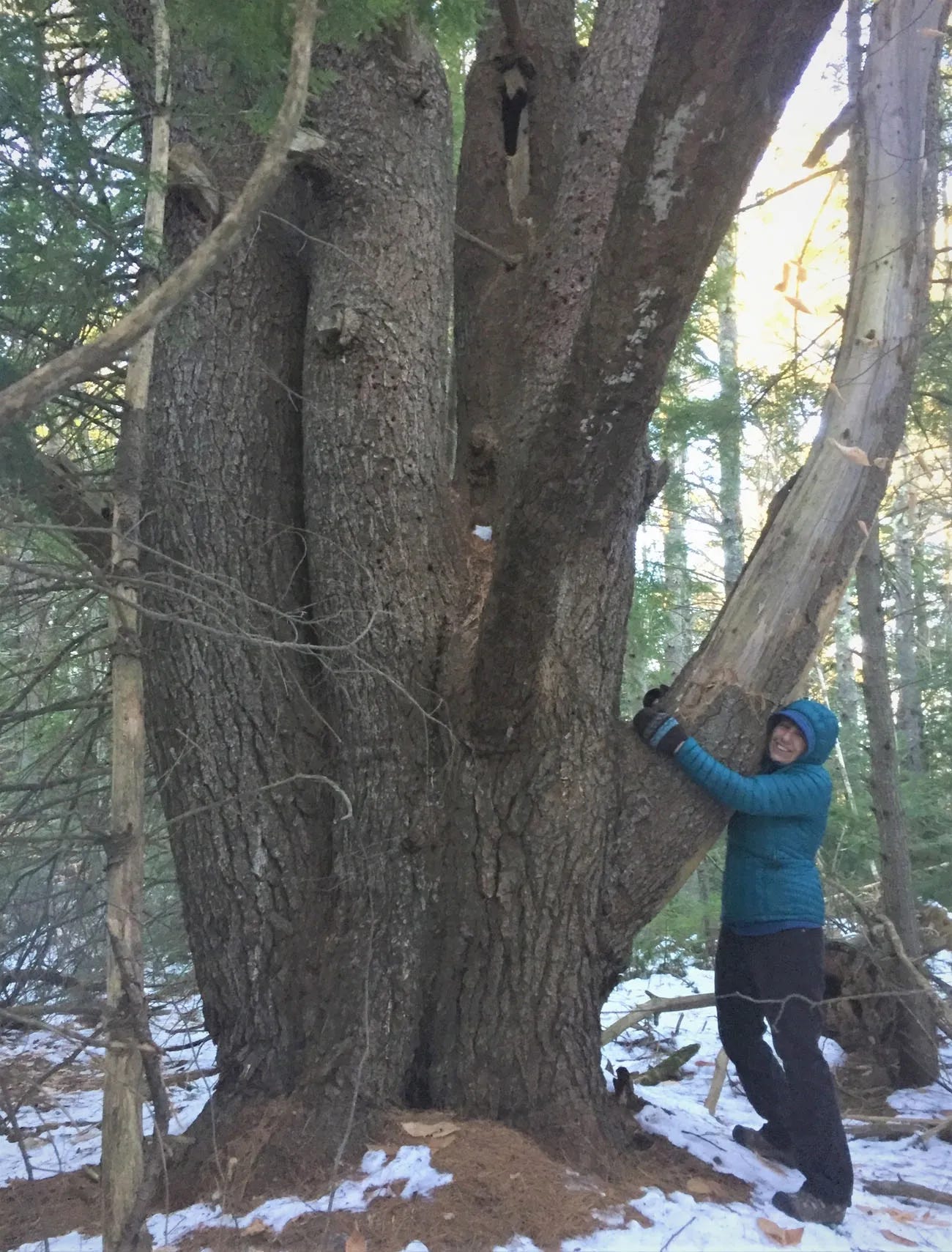
Okay, so if we’re looking at an abandoned field, what else can we learn about it that will help us understand its history? Well, fields are cleared for 3 main reasons; grazing animals, growing grass for hay, or growing intensive crops. Each of these will have different treatments from the farmers, and we can identify them in how the landscape is left after it rewilds.
Clearing Types
The first thing to look for is evidence of a rock wall. These rock walls were not to define property boundaries, but a place to dump the rocks from plowing. If you’re able to find the walls themselves, those can give you some key clues as to how intensively the land was worked— the smaller the rocks, the more intensive farming was done, and smaller rocks, say, fist sized or smaller, are indicative of things like vegetable farming.
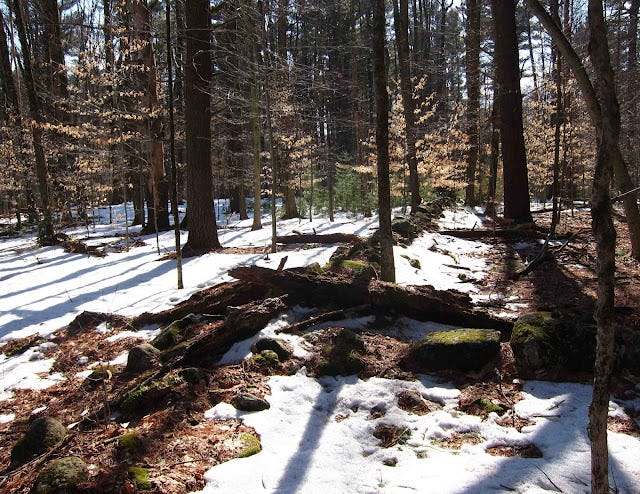
Despite seeming as though these ancient-looking rock walls have existed since the arrival of colonists, it wasn’t really until the early 19th century that these rock walls became prevalent (we talked about this in our piece on sheep fever here)— prior to that, zigzag fences littered the landscape, along with stacks of stumps that were used to keep animals in or out of a property. Obviously, wood rots, so evidence of these older pasture and field markers are long gone. And If there is no wall to be found, it becomes less likely to identify if it was farmed for hay or vegetables, but usually it won’t be hard to identify former pasture. The reason for this is fairly simple— pasture land was typically the land that couldn’t be used for other agricultural endeavors— there will often be poor soil, the land will be less flat because of the lack of plowing and manipulation, and after the land is overgrazed, as it often was, species like junipers will show up— which only grow in poor-nutrient, full-sun locations.
Understanding the forest succession from the forest ecology piece is really helpful in following the histories of many of these farmlands. Most farms that were abandoned were done so as the land was used up— that is, the topsoil no longer produced enough and inputs were more expensive than what the return was on it. These soils were, in short, destroyed. If we recall, destroyed topsoils provide a great place for quick-growing annuals because the perennials have been killed off, whether by compaction or lack of nutrients, and these annuals are commonly known as —mostly— weeds. The weeds cover the land while perennials begin to spring up again, which protect the small shrubs that slowly take over and give way to the fast-growing trees of the early stage forest succession.
Forest Diversity
One of the things we didn’t talk about in this forest succession process is why sometimes those early forests are largely one species, or another, or a good mix, and, well, there is a reason! If you spend any time outdoors, you might be aware that many species of trees will have what’s called ‘mast’ years, during which, say, oaks drop significantly acorns on the ground. The purpose of this, an entire region of trees dropping more acorns in one year, together, is simple— they drop so many acorns that there’s no way the animals can eat them all. It guarantees new saplings the following year. Part of those early stage species’ requirements to be successful is high sunlight and, ideally, minimal grazing. What we will see in these old pastures in particular is that the trees that spring up within a juniper becomes protected from grazing because the juniper isn’t palatable, allowing the tree to get past its most vulnerable stage and to eventually grow large. If you’ve got fruit trees, then you can appreciate this, because there’s nothing more frustrating than trying to protect new fruit trees from local deer— it’s amazing any tree survives.
So, if we understand that trees mostly survive based on having protection from grazers and mast years— that means likely multiple large junipers in a region, meaning a long, exhaustive overgrazing period, since junipers grow slowly, and that the trees likely had seeds from multiple mast years in order to get different species to flow into the field. If the field is primarily, say, sugar maple, then we know that there wasn’t enough time for multiple species to have mast years, drop their seeds, and allow them time to spring up.
While much of reading the impacts of the landscape come from agricultural production, in many parts of the country it’s not hard to find evidence of logging— even if that might not sound like something going on around you. We can start the conversation by talking simply about stumps. How can you tell what kind of tree was growing when all that’s left is a stump?
The first giveaway about a tree can come from whether or not sprouts shot up from the stump— we can eliminate a lot of species just starting there. If the stump doesn’t have sprouts, we can further confirm the species options by looking at the pattern of how it is rotting. Coniferous trees— that is, pines, hemlocks, and spruces, decay from the outside of the stump inwards. Now why is that the case? It has to do with how these trees grow, or if you deal with pine for firewood at all, this will make a lot of sense. The sapwood, that is, the outer zone of the tree’s trunk, is full of resinous sap. To move this sap up and down the tree, large, porous holes run the length of the tree. The heartwood that runs through the center of the tree is more dense, with less storage of sugars and smaller holes, which means less nutrients for bugs and less water penetration for rot. This becomes super obvious if you’ve ever cut down coniferous standing deadwood. White pine, in particular, will have a ring of porous holes that are extremely evident-- large enough for a toothpick to fit into, if the wood has been standing for a decade or more. In some really bad cases, this ring of sapwood will actually just come right off the heartwood when splitting it if it has started to dry rot.
image
While the sapwood is rot resistant, the bark of most coniferous trees is fairly resilient— recall that these trees tend to do well in fire-prone areas because the bark is so thick and tough. Often times, at the very end of the decomposition process, the only way you’ll know a conifer was there is a piece of bark, still like a rock, sticking up from the ground.
Hardwoods, which are not necessarily harder wood, but rather deciduous trees— trees that lose their leaves seasonally, tend to be more rot-prone. These stumps will rot uniformly, and will usually leave little to mark their existence within 30 years. The exception to this rule are rot-resistant hardwoods, the most notable being oak, locust, and chestnut. All of these trees, in this case, not only can be found across the entire continent fairly consistently (or, in the case of chestnuts, had been), but they are also aggressive coppicing species, so often these stumps will have trees growing along their rings. These trees rot from the inside out, and often will show cracks that run from the inside of the stump outwards from the wood shrinking. With these coppicing species, we can estimate the size of the original tree by following the central location of the new sprouts that shot up and making a circle along that pattern.
One of the things you can identify pretty quickly when it comes to cut down trees is why it was cut down. If the trunk was left to rot on the ground, you’ll notice that in whichever direction the tree fell, the trunk is either still there or there may be a line of similarly aged trees where the trunk once stood. These trees often quickly spring up from the body of the tree as seeds fall and draw their nutrients from the fallen tree, versus having to forage it from the raw soil. Further, the fallen tree, by coming down, has opened up space in the canopy for new trees to spring towards. If there’s no evidence of the tree’s trunk, that means the tree was probably logged. It’s hard to imagine massive logging operations where trees seem like they’ve always stood, but in much of the Northeast, a second wave of logging spring up in the early 20th century as the trees that took over the abandoned pastures became big enough to be of value.
If you’ve noticed around your area that all of the forests seem to look kind of the same, this is why— when forests are clearcut, there’s no longer different forests of different ages making a patchwork where different ecosystems can thrive-—instead it’s one monotonous forest stage, which isn’t exciting for us as folks that enjoy the natural world, nor is it good for nature, which has different species specifically suited for different forest ecosystems.
It might seem weird that a tree was cut down and then left to rot, but it happens. It happens when the tree was standing deadwood, it can happen when trees show disease, or it can happen when the wood doesn’t have much value for the person in the landscape and he’s looking for another type of wood and that tree was in the way.
And, of course, this isn’t the only way trees come down in the woods. We’ve talked a bit about human intervention on the landscape quite a bit at this point, but for many of us, myself included, downed trees are a part of the forest landscape that stands out the most— it is the biggest impression when you look out into the woods. When a trunk stretches across the ground tied to a ball of snarling roots, it’s hard not to think of the crash when it fell and it’s even harder to imagine it slowly erasing over time.
Let’s work in reverse order on this subject, since I think it’s easier to understand. You might notice, sometimes, when you’re going for a hike, that in certain areas, the roots of a tree bulge from the soil. Sometimes, this is from the fact that excessive hiking can compact and ultimately cause topsoil to wash away, but you may also notice you’re near a pond. The water table might be pretty high where you are. If you recall from the soil episode, we had talked about the importance of oxygen in the soil, and when it becomes saturated with water instead, roots can’t breathe. Often times, in high-water-table regions, trees will keep their roots higher or even at the surface of the soil. Some trees do this regardless of soil type, so this alone isn’t an indicator of a high water table.
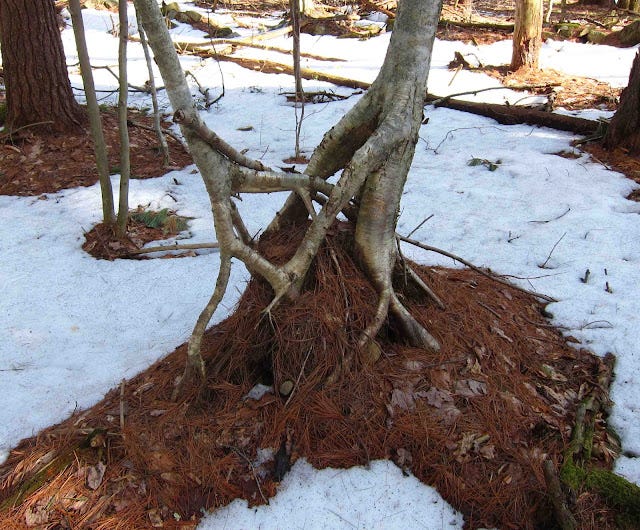
However, often times you might notice it seems that trees sit on small hills, maybe three to five or more feet wide. These raised mounds are called hummocks, which are the remains of downed trees, stumps, or root systems. Think of it almost like a raft above the high water table where the saplings were able to access nutrients in the soil by running roots around the original downed tree-- called a nurse tree-- and then into the soil.
How do you know that the mound is from a downed tree, instead of a rock or a boulder, or any other thing that could have caused an irregularity in the soil? The first giveaway is usually a depression beside the mound. If you think about a root ball springing up from the earth, the roots may stretch ten feet into the air, while the mound where they had once gripped the soil drops accordingly. While the hole does fill in as it catches leaves and so forth, it never fills in fully, and a slight depression will continue to exist long after the tree is a faded memory.
Needless to say, wind is the reason trees get blown down. Right? These blowdown events tell us a lot about the history of the site. Based on the stump’s location — that is, the hummock— and the cradle caused by the roots leaving the earth, we can quickly assess which way the wind was blowing. Unlike deadfalls, when standing deadwood finally weakens enough that a slight breeze knocks down the trunk, major blowdown events usually all fall in the same direction. As you probably know, storms in your area are impacted by jet streams and generally the wind blows based on the tree’s relation to the storm coming through, as all storms not only move as a cohesive unit across the landscape, say, south to north up the east coast, but also in a circular motion, meaning that the northern areas just above the storm will have a different impact from the storm than the areas just south of the storm.
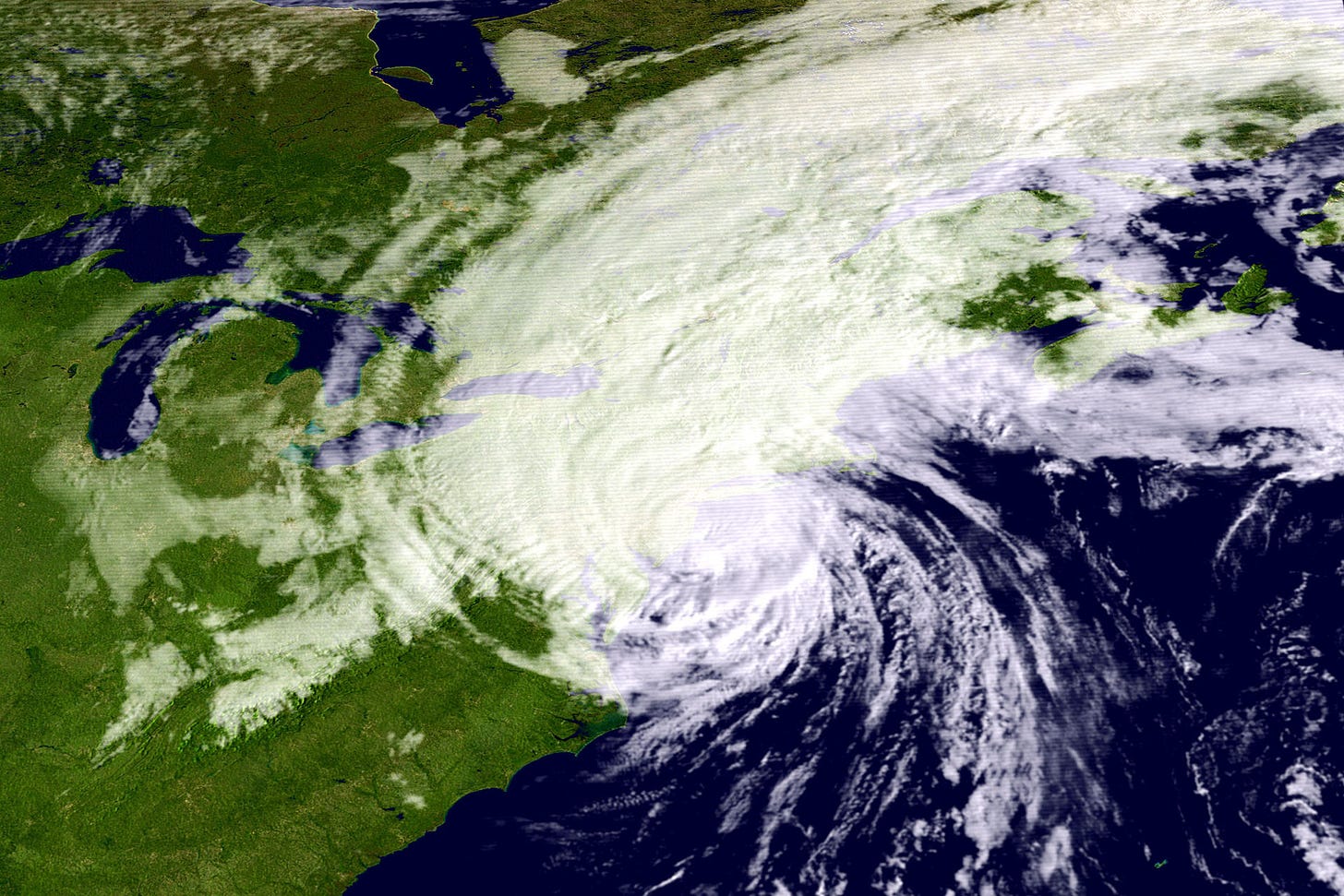
Tornadoes, obviously are an entirely different animal, which fortunately I don’t have to deal with here, but if you do, it may make this process harder. The one easy indicator for tornadoes is that they generally snap the trees at midtrunk height instead of ripping out the roots because of the torque created from the tunnel effect of tornadoes.
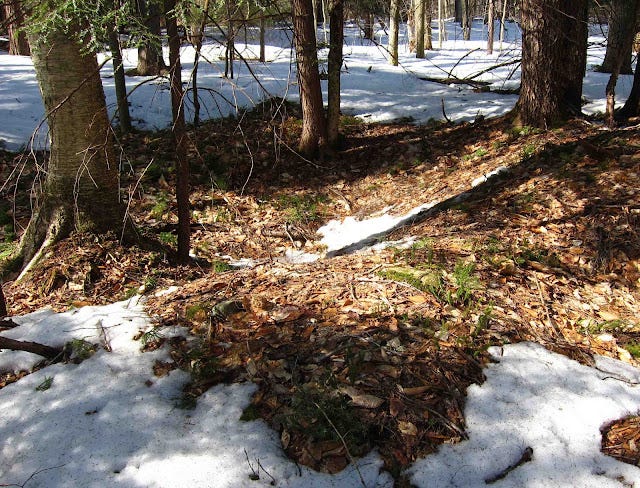
By identifying these pillows of former trees and cradles from former trunk locations, you’ll better be able to identify the history of the landscape, and from an agricultural perspective, identify areas with thicker topsoils— the pillows, versus, say, a boulder under the soil where the topsoil may only be a few inches deep.
What you’ll start to notice, over time and repeated practice, is these subtle aberrations in the landscape tell histories of hundreds of years. If we think back to the stumps discussion— if a hardwood stump takes 30 to 50 years to decay, how long until an entire tree decays? Well, before we even try to date the tree that has fallen, let’s go back to those nurse trees. When the tree comes down, trees with small seeds that grow best when there’s no leaf litter on the soil will quickly try to seed on the fallen tree. Birches, aspens, and pines are common nurse trees in the northern half of North America.
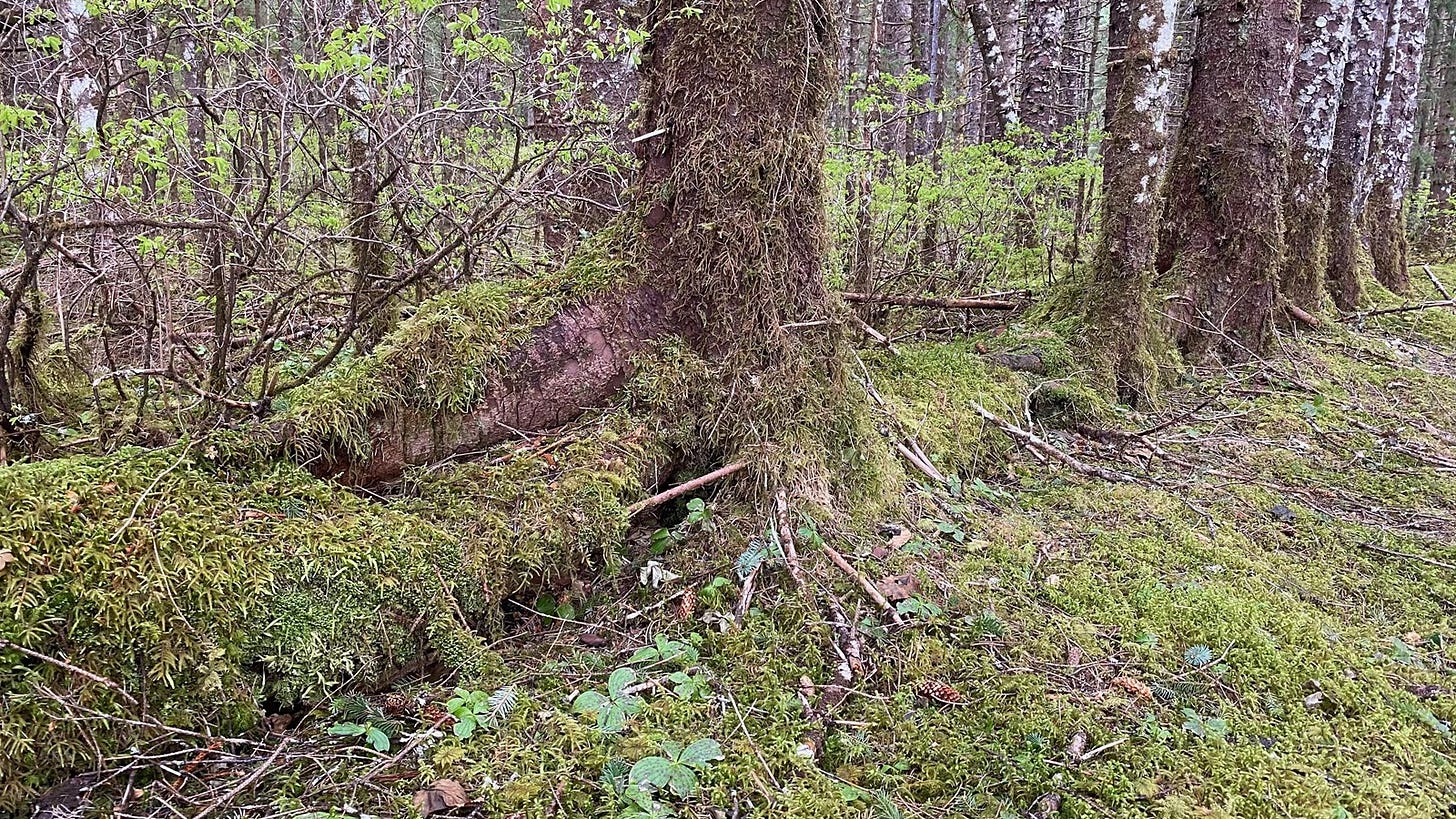
Usually these trees will appear to run in a straight line, along where the tree had fallen, in the landscape, and they’ll all be about the same age. So, if you stand behind the cradle, looking towards the pillow, if the tree was fairly straight, you should be able to follow the length of the tree as a handful of trees the same age all grow in that straight line. Now that you’ve found the tree line, you can estimate the tree ages, and you know the tree fell at least that long ago.
When storms roll through, one of the interesting things you’ll discover is that generally, the trees that come down first are the ones who peer out above all the other trees— by keeping the same height at the canopy, the trees are more resistant to strong wind blasts, while the ones that reach out above it tend to be the first ones to fall, as they bare the brunt of the storms alone. Depending on the amount of canopy the tree had claimed, this can often lead to weakening of that top canopy, and often times multiple trees will then come down as the storm rages on. So, you’ll often notice there are multiple pillow and cradles, all aged about the same, with similar nurse tree patterns. It might not be obvious at first, but after practice you’ll quickly see this in the landscape.
Now, you can assume that these seedlings didn’t spring up right away. Chances are, it was likely even a couple of decades before the bark had broken down enough to allow moss and ultimately the seedlings to have access to the nutrients to sprout from the nurse tree. But, now you’ve got about a 10 year window to identify when the tree likely came down, and a quick google search can point to the largest storms during that time period. Further, by knowing the direction the wind was blowing, you can pair that information down to which storms met those requirements or location— if a storm hit, say, Boston, were you far enough north or south from it for the prevailing winds to cause the tree to blow down in that direction? To me, I’ve always loved history, and bringing history into nature, where I can experience a storm through its aftermath that impacted generations before me, is a pretty cool concept.
Now that we can identify the time period of the fallen tree, we can learn even more about our landscape. Let’s focus on the trees that did grow around these trees that sprung from the nurse tree— particularly the ones larger than the saplings that sprung up from the down trees. If they’re larger than the saplings, they existed before the tree had fallen, right? What species are those trees? If all of the larger trees are, say, white pine, we can assume that the fallen tree or trees were probably white pines. While forests are not homogenous, we do understand that in forest succession, generally only 2 or 3 species become the dominant species in a forest, and if we can identify which species fit that category of that time period, we can make some assumptions.
In many cases, we can confirm this by looking at the patterns that remain from the nurse log. A rule of thumb to keep in mind is that— usually— fast-growing trees also quickly rot. There are exceptions, like locusts, but as a rule of thumb, for birches, maples, beeches, and pines, this is generally true. For all of those except for pines, this quick rot is too quick to be a successful tree for nursing because of its decomposition pattern. We had talked about the differences of the decomposition processes between hardwoods and softwoods— hardwoods rot from the inside out, while softwoods rot from the outside in. Which do you think is likely to be a better host for seedlings and mosses? Probably the ones that rot from the outside in. So, trees like hemlock and pine will quickly decompose, which allows for moss to take over and provide a warm, wet environment for those seeds to fall and sprout new trees.
Now, I want to circle back to the conversation we started about exposed roots. While a high water table is reason for roots to be exposed, one thing you might notice is that often, the nurse log has all but disappeared. A trunk that may have been 2 or more feet in diameter has broken down into the soil, and appears to be nothing more than maybe a subtle shift in the landscape. While the roots are malleable enough while underground to slowly evolve with the drop in the landscape, they will often burst from the landscape floor and is a clear indicator of a nurse log.
Lastly, we can roughly confirm the size of the fallen tree by looking for evidence. Trees like pines and hemlocks, conifers that rot from the outside in, do so at a slightly faster rate than they grow. With a sharp pole, you should be able to stick it right through the ground where the nurse log once stood-- you know there wouldn’t be any rocks in the way. If you’re hitting something hard, you’re hitting that heartwood from the tree. We can assume based on our understanding of how the canopy shields smaller trees from the brunt of the storm that the nurse tree was larger than the trees around us, and we know how old the trees that sprung from our nurse log were, so does the presence or absence of heartwood confirm our assumptions?
Let’s use a quick example from a tree in my backyard. We find a pillow and cradle, and a handful of smaller white pines stretch north from this formation, showing evidence of a nurse log. The white pines are about 60 years old, and large, towering white pines over 100 years old shoot up from around us. We can safely assume the nurse log was a white pine tree that came down probably 80 years ago. That’s just around 1940, so it was probably the storm of 1938, the worst hurricane to ever hit New England. Not only can I tell based on the age, but the storm ran to the west of my region, which isn’t fairly common, and hurricanes spin counter-clockwise in the northern hemisphere, meaning a storm to my west is blowing south to north, so this tree fell in that direction.
Because the tree was above or a part of the top canopy, I know it was at least 40 years old when it came down. Using a grounding rod from my electric fence, I pushed it through the ground recently to estimate the tree age, and I did not hit any heartwood, meaning not only had it fully decomposed, but since the storm was 80 years ago the tree was probably less than 60 years old using the estimated time it would take a pine tree to rot, but at least 40 years old, since that’s how old the remaining trees were that cover the canopy today. It’s kind of like finding X in an algebra class.
You can go further down the rabbit hole— if the tree was, say, 60 or so years old, that means it seeded in 1880ish, which is interesting because if we think about the history of the landscape here, in the middle 19th century was when many farms were abandoned as the sheep craze of the early 19th century ended, suggesting that the nurse tree may have been one of the trees that sprung up from one of the last pasture fields of the 19th century merino sheep rush. By identifying a hump in the ground, you can uncover 200 years of history. Pretty cool, right?
The last thing I want to bring up on this subject stems around a much more pragmatic understanding of reading the landscape, and that relates to the land itself. I know a lot of folks want to test for this and that, and I’ve hinted in previous episodes that these tests aren’t always necessary. They are absolutely useful, and if you can afford them, go for it, but if not, there are workarounds. Simple assessments like looking for eco-indicators, species that have specific requirements for survival, are generally very useful in making quick, rough assessments of the landscape. Species like ferns are often indicators for high moisture and nutrient content in the soil.
These eco-indicators usually have a narrow requirement for survival for a specific thing—whether it’s pH, shade, water, minerals, and so on. By tying these eco-indicators in with the things we learned in the forest succession episodes, you can quickly increase your knowledge of your landscape, increase the likelihood of foraging successfully, and increase your likelihood of hunting for specific species by identifying plants in their diet.
However, there is one specific thing that’s worth keeping in mind, and not only can it explain human interference but also the changes of a site’s history, and that is germination niche. What this means is that certain species often need a very specific set of circumstances to germinate, but if they’re transplanted, they can do fine. This is why many species that litter landscapes never have new seeds germinate nearby— the conditions of the site will not provide the necessary environment for seeds to germinate, despite the fact the tree might thrive.
Generalists, on the other hand, can generally survive in a broad range of conditions. Oaks, red maples, and pines can be found almost everywhere across the continent, although pines will quickly take over in sandier, lower-pH regions because of less competition. However, specific varieties thrive in specific conditions. White oaks, because of their thick bark, tend to do better in fire-prone areas, and are more willing to deal with drier conditions than red oaks. Jack pines will claim the crest of a rocky mountain, where nothing else can live, and work with the landscape to break chisel down the rock into sand. Silver maples are more capable of dealing with water-saturated riparian zones along the sides of rivers. With diversity, species are able to specialize and thrive in the conditions of every site.
Ultimately, the landscape diversity is defined by five factors— disturbance (that is, the stage of forest succession), topography, substrate, climate, and water. We covered this from a topical standpoint when we did the forest succession episode, and now we’ve dug into the content from the perspective of an archaeologist. And despite having spent almost an hour on the subject, we’ve really only scratched the surface of it.
One last note— Saratoga Woods Waters provided a number of the images shown here for examples, so go check out their blog on the subject here!
If you’ve enjoyed this piece, which is equal to a 25 page chapter, of (so far) a 382 page book with 137 sources, you can support our work a number of ways. The first is by sharing this article with folks you think would find it interesting. The second is by listening and sharing the audio version of this content (Episode 22), the Poor Proles Almanac podcast, available wherever you get your podcasts. If you’d like to financially support the project, and get exclusive access to our limited paywalled content, you can subscribe on Substack or Patreon, which will both give you access to the paywalled content, and in the case of Patreon, early access to the audio episodes as well.
https://www.thelivingurn.com/blogs/news/79236289-how-to-determine-the-age-of-a-tree
Wessels, T. (2010). Forest forensics: A field guide to reading the forested landscape. Countryman Press.




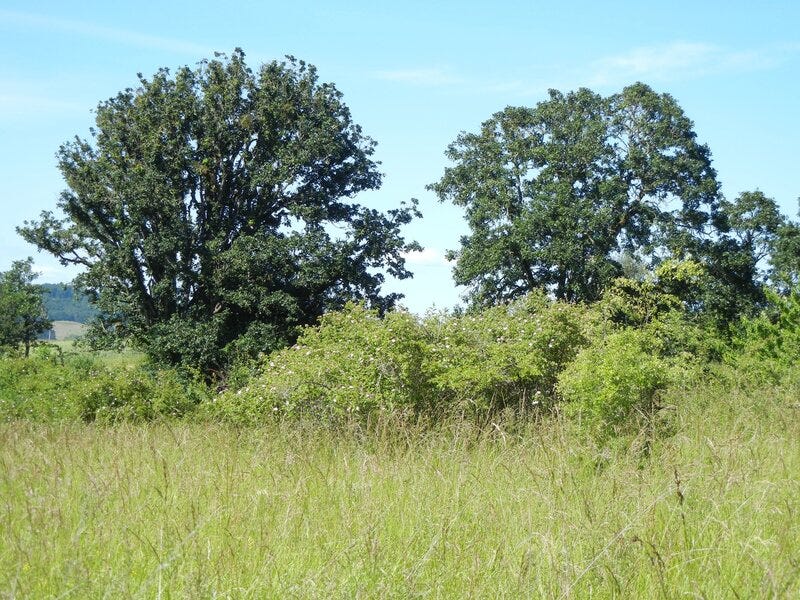
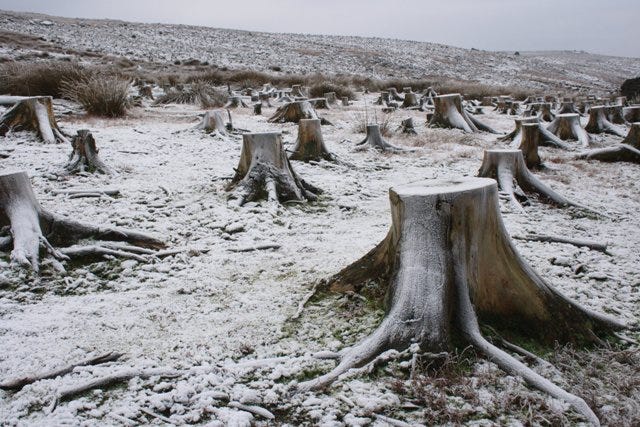
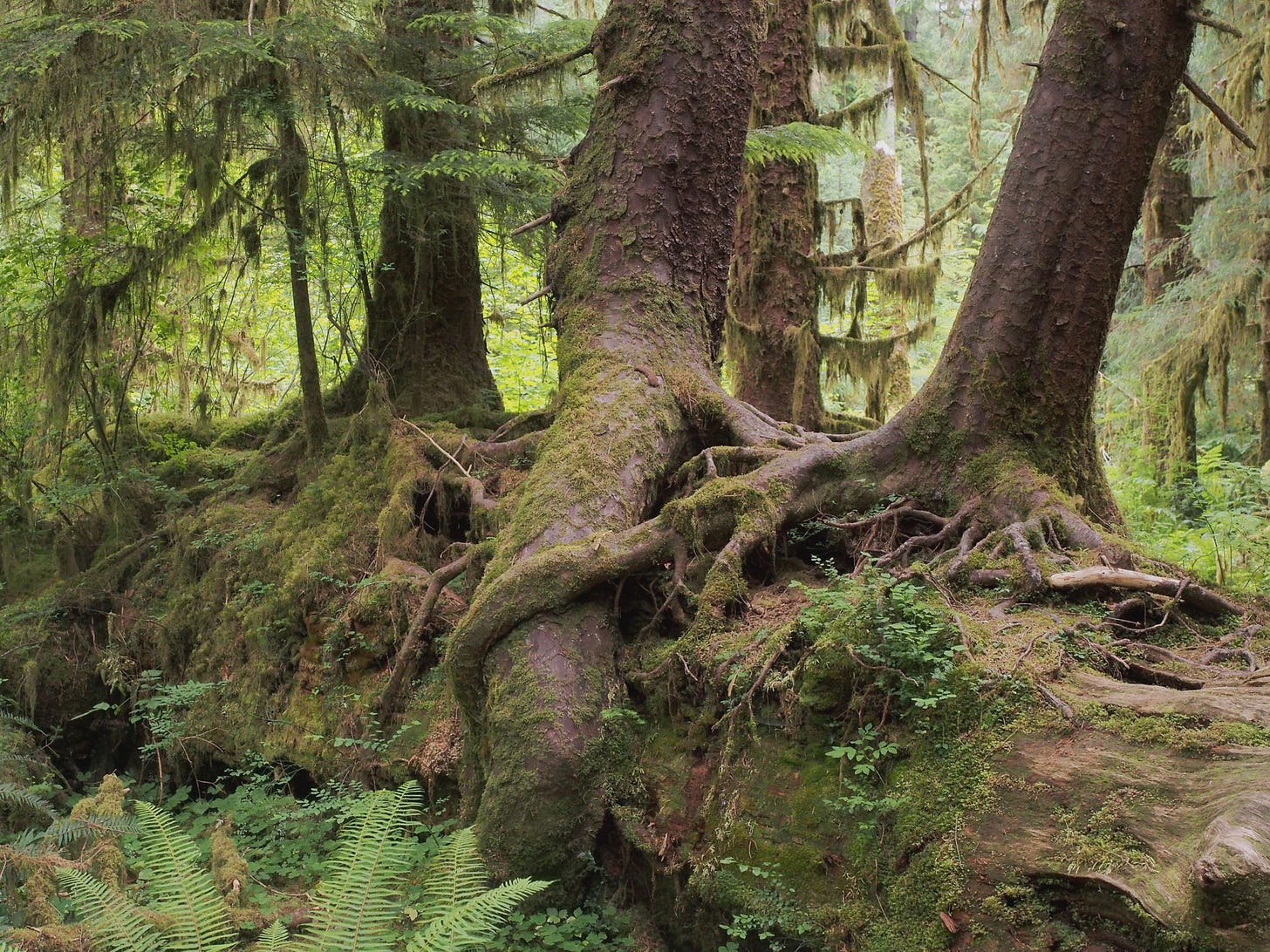
Thank you for taking the time to write this article. I would have gone through life without knowing any of this while visiting trails every week. Thank you for the work you do.